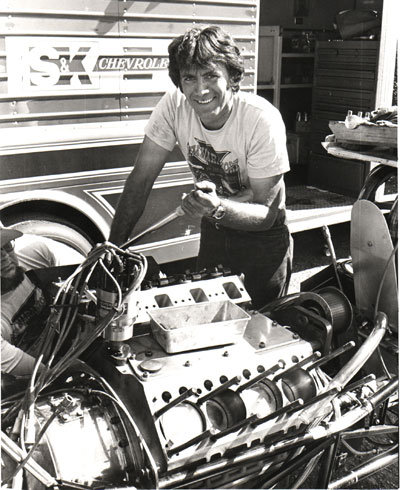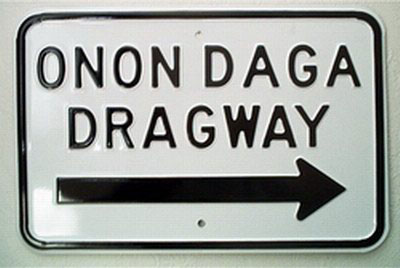

In a Pryor life, plus more ghost tracks
 |
|
Friday's ghost-tracks column inspired a lot of mail and a little bit of sadness from those who had attended the long-gone U.S. 30 track. I'll get to some of that feedback in a while, but today is the perfect chance to share something I've been sitting on because the guy I'm going to talk about spent a lot of time racing at U.S. 30 and other Midwest tracks in the 1960s and '70s.
Bill Pryor is a three-time Division 3 Top Fuel champ (1975, 1976, and 1979) who, with partner Jim Naramore, routinely used to give the business to drivers such as Shirley Muldowney and Dick LaHaie in the Land of the Winners.
I first heard from Pryor a month or so ago after my "Dry Hops in Heaven" column (July 7). His name is unique enough, and being the inquisitive sort, I took a chance and replied, "Is this the former Top Fuel driver?" It was, and I quickly asked him about the Hendrick Motorsports signature on the bottom of his e-mail. Did he work for the NASCAR giant?Â
"My oldest son, Kelly, left John Force Racing about 1998 to become the 'engine tuner' on the 5 car when Terry Labonte drove for the team," he said.Ìý"I came down two years later to see what Kelly was doing and what this world was all about, and Randy Dorton offered me a job. I went back to
Pryor is involved in purchasing for the mammoth NASCAR operation. "I get to spend all the money," he joked. "Actually, I do the purchasing primarily for the engine/CNC shops. I take care of new parts and the disposal of used race cars and used parts with a staff of 14."
My, how far he's come from his drag racing roots.
Like many future fuel racers, Pryor got his start in door cars and with a dream.
"My first trip to
After his discharge in 1963, he bought a ’63 Max Wedge Belvedere that he raced throughout the Midwest, which was followed by a ’64 Hemi Belvedere that he ran for one year ("much too expensive for my farming budget"), then a ’57 Corvette and a C/Gas ’55 Chevrolet.
"At the time, I did not even have a garage," he said. "If there is one person responsible for my early success, it was Bobby Hees in New Canton, Ill. He was the local hero, engine guy extraordinaire. He had a lathe, hone, valve equipment, etc. and literally taught me everything about engines. He is still a great friend, and we stay in touch about all forms of racing."
Pryor moved a step closer to his Top Fuel dreams when he purchased a front-engine dragster in 1968 and competed on a Midwest fuel circuit – a run-whatcha-brung amalgamation of blown fuelers, injected fuelers, blown alcohol, and injected alcohol cars -- for the next four years with great success.
|
 |
 |
|
In 1972, Pryor decided to go racing full time and teamed with the late Chuck Hurst. They bought a new Woody Gilmore car (originally built for Guy Allen, father of Jeb and Les) and a blown fuel Donovan powerplant from Ed Pink. Because he was in
For the next two years, the team ran hot and heavy on the IHRA and AHRA trails and did a lot of match racing in places such as Tulsa; St Louis; Indiana (U.S. 30); Union Grove, Wis.;
"I have a couple of memories from U.S. 30. One was a bullet going through the side of Paul Longenecker's trailer after the race during a disagreement in the stands. Another was when a carload of brothers came by to see why Kuhl & Olson lost in the final. The rear end broke on the starting line, but telling them was not good enough; Kuhl had to remove the third member and prove to the boys that it was broke. They were satisfied and drove away. The U.S. 30 stands were always packed, lots of money changing hands. For me, it was just a paycheck. I knew I could stop by there, make my two runs, and go on to the next one."
They won the AHRA Nationals in
Naramore bought out Hurst in late 1974, beginning a partnership that would last the rest of Pryor's career. Longtime crewmember Tuck Jones worked that winter at Jerry Dawson’s shop in St Louis to help build the team a new chassis for an unforgettable 1975 season that culminated with the Division 3 championship; they finished ahead of Dick Rosberg, Dave Settles, Jim Bucher, and others. The team won the 1976 division title as well, in addition to the AHRA Nationals in
The year 1977 is one that Pryor would just as soon scratch from his memory. Pryor was spending the winters in sunny
Then disaster struck again.
As the team was loading up the car to leave Martin after Pryor's first race back, their generator exploded, and Pryor spent the next three weeks in a Kalamazoo, Mich., burn center and the remainder of 1977 recovering. The team sold the star-crossed Funny Car and concentrated again on Top Fuel.
About the only good thing to come out of 1977 was the beginning of a long friendship with Pat Foster and Jim Hume, who had rebodied and retinned the Funny Car for him.
Pryor and Naramore were the division runner-up in 1978 before winning it all again in 1979, the year that the team finally cracked into the national top 10 with an impressive sixth-place finish behind a handful of top talent: Rob Bruins, Kelly Brown, Garlits, Muldowney, and Bob Noice.
Pryor also traveled to
After a two-year stint working for Bill Simpson and three more in sales at Donovan Engineering, Pryor spent 15 years, from 1985 through 2000, as the general manager at Rodeck Engineering before finding his way to Hendrick.
"I had a great time during those years and made lifelong friends from coast to coast," he said. "It was fun just writing some of it down."

 |
As previously noted in this column, as sad as they are to see, people love photos of the ghost tracks, sites of famous tracks that are no longer there but where often a part of the track remains. Where no parts remain, memories do.
Tim Russell well remembers U.S. 30. "I lived on the south side of
I received no fewer than five links to WaterWinterWonderland.com, a Web site "dedicated to preserving the wonderful history of the State of
Detroit Dragway, which played host to the NHRA Nationals in 1959 and 1960, closed in 1998 and was sold to developers, who built a large industrial complex on the site. Tri-City, in
Reader Randal Cronk took his wife to Tri-City when they were dating, "and since she liked it, I married her," he wrote. Cronk runs a high school auto club in
Motor City Dragway, in New Baltimore, opened in the summer of 1957 – it originally was funded by car clubs such as the Bearing Burners and Tappet Tickers -- and closed in 1978 due to, of all things, a fish-fly infestation that drove away spectators. According to a 2004 posting on the site by the late Top Fuel racer Chuck Kurzawa, the track was originally called MHRA (Michigan Hot Rod Association) Drag Strip. "It was concrete and narrow," he recalled. Kurzawa's son, Chuck III, said that his father and Connie Kalitta once even thought about purchasing the track.
 |
Onondaga Dragway (known as "Daga" to the locals) was on Bellevue Road between Onondaga and Leslie and active from 1962 and, like Tri-City and
According to the site, lesser-known M-37, in Brohman, was closed in the late 1970s due to lack of participants and a lawsuit involving one of the racers. Nicks 41, an outlaw strip on the grounds of the old Dexter Landing Field on U.S. 41 near Ishpeming, was used in the 1970s and 1980s before Cliffs Iron, which owned the mineral rights under the strip, closed the track, the site of which today is reportedly a gravel pit.
|
John R. Shupp dropped me a photo of his old track, Pocono Drag Lodge, which he and his wife "rediscovered" last year on one of their motorcycle journeys. The word "Start" is still clearly visible on the old racing surface of the track, which was in northeast
|
"Since you're on the subject of old racetracks, maybe a timely nod to the now-defunct Lakeland Int'l Raceway in Memphis would be fitting, especially since the Mid-South Nationals [just ran]," wrote Louis Kimery. "I spent many a day at this place in the '70s, and although I enjoy today's racing scene and the much nicer facilities, I miss the era of drag racing that
|
Todd Polk wanted to share his old track, the one he grew up attending as a teenager in the mid-1970s: Smokin' Alamo Dragway, which lived from 1974 through 2004.
"I remember going there with my dad and a buddy when I was 14 in '76 to see the AHRA Nationals - what a thrill!" he wrote. "My buddy and I were in the top row of the grandstands, leaned over the railing, oohing and ahhing at the Funny Cars and Top Fuelers in the staging lanes. Unbeknownst to us, the first pair of Funny Cars was starting up. My dad (being the fun-loving guy he was) didn't say a word to us. And then the whole world changed. Tom Hoover in his Showtime Funny Car hit the throttle for his burnout, and my buddy and I about went over the railing! My dad, of course, had both of us by the belt so that we didn't go flying. What a welcome to drag racing! Been hooked ever since. The old track closed in 2004, a victim of the times, performance improvement, and the new track across town."
Greg Siekierko, who lives just outside of
|
And finally, ever wonder why
Got some photos of your old ghost strip? Let's see 'em!



























































